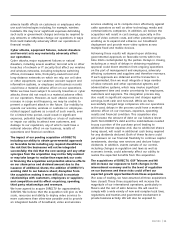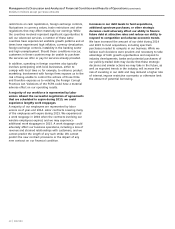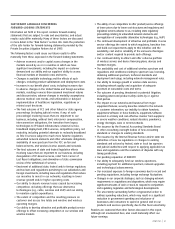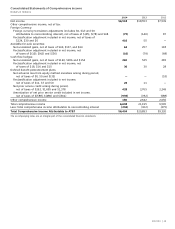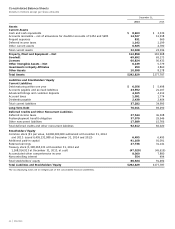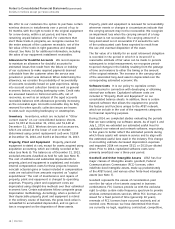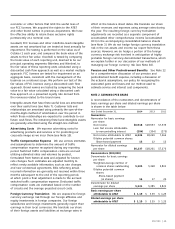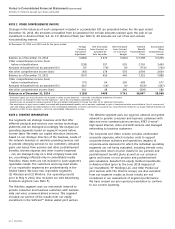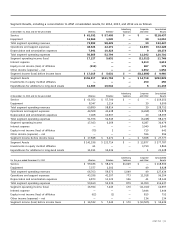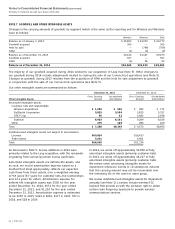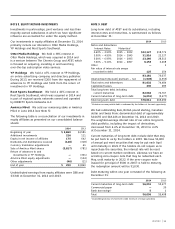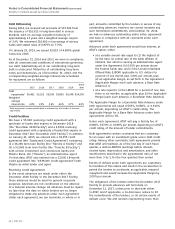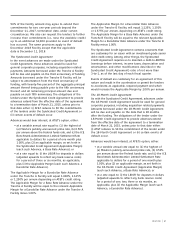AT&T Wireless 2014 Annual Report Download - page 50
Download and view the complete annual report
Please find page 50 of the 2014 AT&T Wireless annual report below. You can navigate through the pages in the report by either clicking on the pages listed below, or by using the keyword search tool below to find specific information within the annual report.
Notes to Consolidated Financial Statements (continued)
Dollars in millions except per share amounts
48
|
AT&T INC.
Property, plant and equipment is reviewed for recoverability
whenever events or changes in circumstances indicate that
the carrying amount may not be recoverable. We recognize
an impairment loss when the carrying amount of a long-
lived asset is not recoverable. The carrying amount of a
long-lived asset is not recoverable if it exceeds the sum
of the undiscounted cash flows expected to result from
the use and eventual disposition of the asset.
The fair value of a liability for an asset retirement obligation
is recorded in the period in which it is incurred if a
reasonable estimate of fair value can be made. In periods
subsequent to initial measurement, we recognize period-
to-period changes in the liability resulting from the passage
of time and revisions to either the timing or the amount
of the original estimate. The increase in the carrying value
of the associated long-lived asset is depreciated over the
corresponding estimated economic life.
Software Costs It is our policy to capitalize certain
costs incurred in connection with developing or obtaining
internal-use software. Capitalized software costs are
included in “Property, Plant and Equipment” on our
consolidated balance sheets. In addition, there is certain
network software that allows the equipment to provide
the features and functions unique to the AT&T network,
which we include in the cost of the equipment categories
for financial reporting purposes.
During 2014, we completed studies evaluating the periods
that we were utilizing our software assets. As of April 1 and
July 1, 2014, we extended our estimated useful lives for
capitalized non-network and network software, respectively,
to five years to better reflect the estimated periods during
which these assets will remain in service and to align with
the estimated useful lives used in the industry. This change
in accounting estimate decreased depreciation expenses
and impacted 2014 net income $513, or $0.10 per diluted
share. Prior to 2014, capitalized software costs were
primarily amortized over a three-year period.
Goodwill and Other Intangible Assets AT&T has four
major classes of intangible assets: goodwill, Federal
Communications Commission (FCC) licenses, other
indefinite-lived intangible assets, made up predominately
of the AT&T brand, and various other finite-lived intangible
assets (see Note 7).
Goodwill represents the excess of consideration paid
over the fair value of net assets acquired in business
combinations. FCC licenses provide us with the exclusive
right to utilize certain radio frequency spectrum to provide
wireless communications services. While FCC licenses are
issued for a fixed period of time (generally 10 years),
renewals of FCC licenses have occurred routinely and at
nominal cost. Moreover, we have determined that there
are currently no legal, regulatory, contractual, competitive,
We offer to our customers the option to purchase certain
wireless devices in installments over a period of up to
30 months, with the right to trade in the original equipment
for a new device, within a set period, and have the
remaining unpaid balance satisfied. For customers that
elect these trade-in programs, we recognize revenue for
the entire amount of the customer receivable, net of the
fair value of the trade-in right guarantee and imputed
interest. See Note 16 for additional information, including
the sales of our equipment installment receivables.
Allowance for Doubtful Accounts We record expense
to maintain an allowance for doubtful accounts for
estimated losses that result from the failure or inability
of our customers to make required payments deemed
collectable from the customer when the service was
provided or product was delivered. When determining the
allowance, we consider the probability of recoverability
of accounts receivable based on past experience, taking
into account current collection trends as well as general
economic factors, including bankruptcy rates. Credit risks
are assessed based on historical write-offs, net of
recoveries, as well as an analysis of the aged accounts
receivable balances with allowances generally increasing
as the receivable ages. Accounts receivable may be fully
reserved for when specific collection issues are known
to exist, such as pending bankruptcy or catastrophes.
Inventory Inventories, which are included in “Other
current assets” on our consolidated balance sheets,
were $1,933 at December 31, 2014, and $1,148 at
December 31, 2013. Wireless devices and accessories,
which are valued at the lower of cost or market
(determined using current replacement cost) were $1,858
at December 31, 2014, and $1,031 at December 31, 2013.
Property, Plant and Equipment Property, plant and
equipment is stated at cost, except for assets acquired using
acquisition accounting, which are initially recorded at fair
value (see Note 6). The balance as of December 31, 2013,
excluded amounts classified as held for sale (see Note 5).
The cost of additions and substantial improvements to
property, plant and equipment is capitalized, and includes
internal compensation costs for these projects; however,
noncash actuarial gains or losses included in compensation
costs are excluded from amounts reported as “capital
expenditures.” The cost of maintenance and repairs of
property, plant and equipment is charged to operating
expenses. Property, plant and equipment costs are
depreciated using straight-line methods over their estimated
economic lives. Certain subsidiaries follow composite group
depreciation methodology. Accordingly, when a portion of
their depreciable property, plant and equipment is retired
in the ordinary course of business, the gross book value is
reclassified to accumulated depreciation, and no gain or
loss is recognized on the disposition of these assets.



